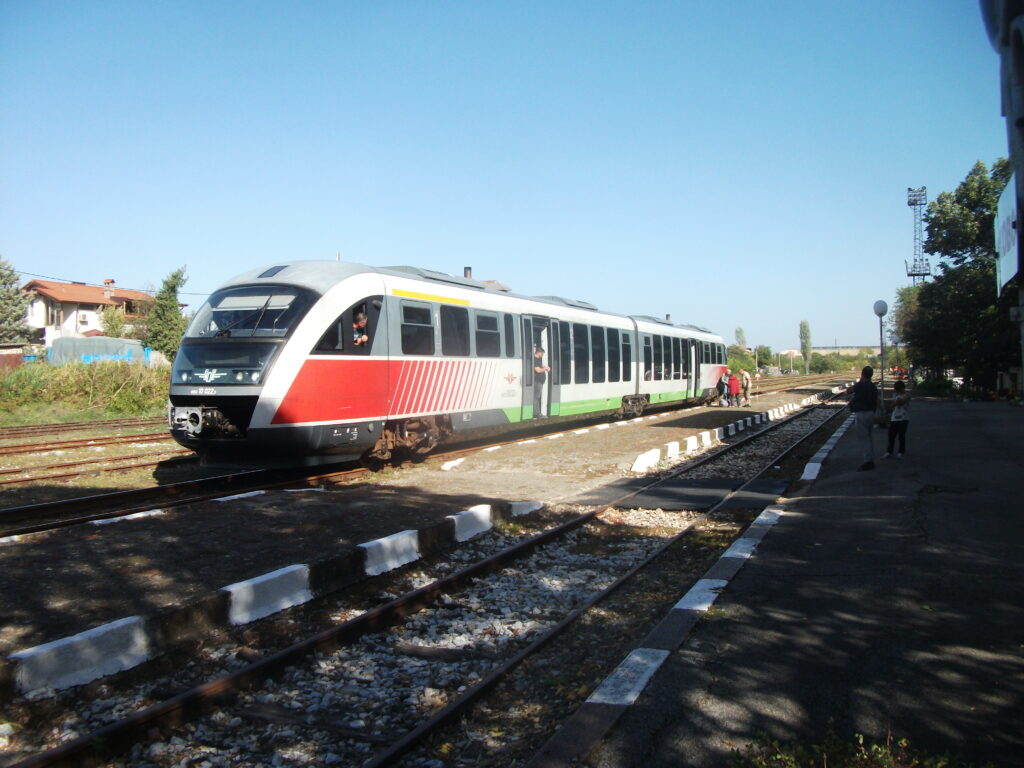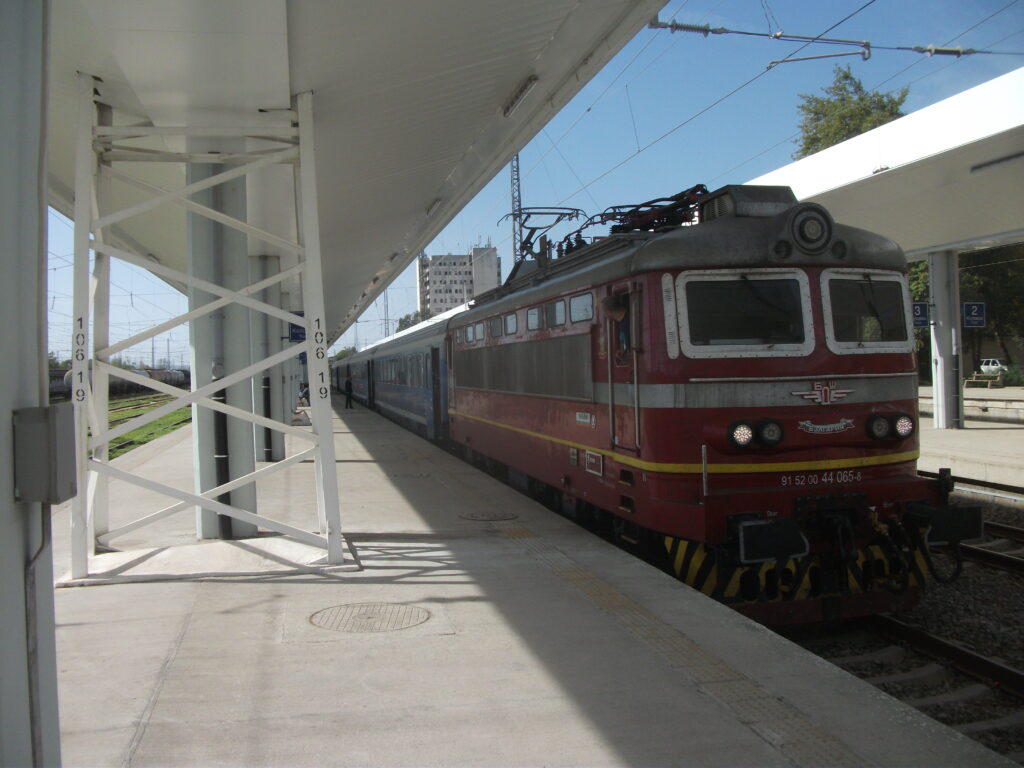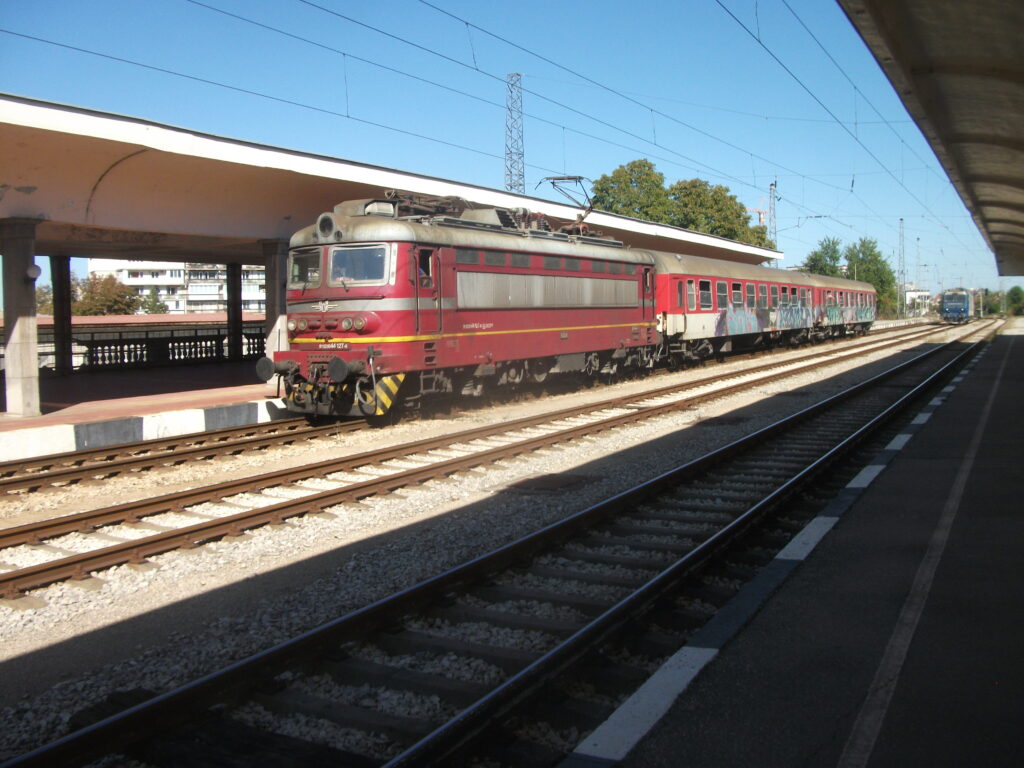Swiss Railways train in Zurich Station
My only previous visit to Bulgaria was in 1995 and another was long overdue. It may not be everyone’s first choice but I decided to do the whole trip by rail. Consulting maps, online travel planners and the European Rail Timetable I concluded that the best route for me was via London, Bruxelles, Frankfurt-am-Main, Vienna, Budapest and Craiova to Vidin in Bulgaria. The return would be from Ruse via Craiova, Timisoara, Budapest and the outward route. Of course I had no idea that severe floods would close the high speed line between St Polten and Vienna a few days before my trip.
These days I take the relaxed approach to travel and include overnight stops in good hotels allowing dinner in great restaurants.
MY OUTWARD JOURNEY TO BULGARIA:
My journey took me from Northallerton to London, then by Eurostar to Bruxelles where the fifteen-minute connection gave me time to nip down to the Metro level to get a copy of new Bruxelles tram and bus map before boarding the ICE train to Frankfurt-am-Main where I enjoyed a meal in the Bord Restaurant.
Having discovered that due to restrictions caused by flood damage the ICE from Frankfurt-am-Main to Vienna would be terminated at Passau from where I would have to take the local train to Linz and then a Railjet train to Vienna I decided that an earlier start was better than a late arrival. The hotel prepared me a ‘breakfast box’ which I collected as I left for the train. The connections worked like clockwork and I arrived in Budapest at the time I had originally planned.
The next day was straightforward. I took a through train from Budapest to Sibiu (Romania) where I planned to spend two nights. This was a twelve-hour journey which arrived thirty minutes late in Sibiu due to major track work in Romania. Having researched the journey I knew there was no restaurant or buffet car on the train, so I stocked up at Keleti station which has a great choice of small shops.
After my break in Sibiu I took the train to Craiova, a trip that included two changes of train and a rail replacement bus, all of which were detailed on the CfR (Romanian railways) website in English. This rail replacement bus is worth a mention as even the train driver came with us, shutting down one train and starting the second one up which, naturally, delayed the journey. After a night in a wonderful hotel I took the daily train from Craiova in Romania to Vidin in Bulgaria. Only four passengers crossed the border. Here a surprise awaited me. Romania and Bulgaria are both in the EU and both about to become part of the ‘Schengen countries’ yet we disembarked into a secure area and had our passports taken off us for processing in an office. We were then let through into Bulgaria but had to wait twenty minutes for our passports to be returned.
ANTI-CLOCKWISE AROUND BULGARIA:

A two hour wait for my onward train gave me time to walk round the city, acclimatise myself to everything being in the Cyrillic script, find an ATM to get some currency and buy lunch in a bakery. I travelled round Bulgaria in an anti-clockwise direction stopping in Vraca, Pleven, Sofia, Pazardzhik, Plovdiv, Haskovo, Stara Zagora, Sliven, Burgas, Varna and Ruse. I had a fabulous time travelling through wonderful scenery, visiting trolleybus systems, enjoying incredible food and experiencing the kindness of strangers.
The population of Bulgaria is only just over six million and declining as more people move to the west. Trains are infrequent on most lines and in parts of the country virtually no-one speaks English. Where restaurants didn’t have an English version of the menu they always found someone to translate for me. In Varna I wanted to buy a day ticket for the buses but the machine at the bus stop wasn’t working so I asked a bus driver standing by their bus for help. They didn’t understand me but a passing young woman, stopped and asked if I would like her to translate, which she did. Through this I discovered that there was a machine on the bus. The time came to depart, the bus drew up to the departure point, I boarded and went to the ticket machine. We set off but came to a halt after 100 metres, when the driver left her cab and came to operate the machine for me. Just one example of the kindness of strangers that I experienced.

Rail travel in Bulgaria is a wonderful experience. Train speeds are slow by our standards giving plenty of time to enjoy the scenery. Most of the inter-city carriages are cascaded from Deutsche Bahn and are very comfortable. Inter-city trains no longer have buffet or restaurant cars and most station cafes or buffets are permanently closed. However there are usually shops or stalls where supplies can be purchased. I never had a problem finding a seat on a train despite travelling without seat reservations and I was never asked to move even though most people had reservations. Except at minor halts, station names are both in Bulgaria’s Cyrillic script and a western transliteration. Local trains are either multiple units or loco-hauled with only one or two carriages. Communist era rolling stock is still common.
The appearance of the trains is uninviting due to the blight of graffiti. I only saw one train without graffiti plastered across the exterior of passenger areas, often over the windows. Conversely, it was rare to see a loco or freight wagon with graffiti and I only saw one bus with graffiti during my visit. Other than the ex-DB IC stock the interior of carriages looked old and tired but was invariably spotless without a trace of litter. The staff were very efficient and helpful and whenever my journey involved a change of train or a replacement bus they came to me just before the relevant station and, despite lack of a common language, explained where my train or bus would be found. They travelled on the replacement buses, did a head count before setting off and made sure I found the onward train – even if it was the only one there.

Three of my journeys involved replacement buses. The need to serve remote villages enabled me to see the real Bulgaria with a different pace of life. On country roads we rarely saw another moving vehicle, in one case travelling twenty minutes at 60-80km/hr without seeing one. Even in villages there were few parked cars let alone moving ones.
Generally speaking train time keeping is good but delays do happen, largely due to the vast amount of upgrading work in progress. Major projects involve modernising or replacing station buildings along with track renewals, re-alignment and dualling. Inevitably this leads to schedule changes and delays, which occasionally are significant. Where the work is finished the result is excellent and train speeds much faster. The Bulgarian railways website has an English version and is frequently updated with changes, including full schedules of replacement buses and should be checked daily.
Level access to trains is virtually non-existent. At many stations access to platforms, where they exist, is across the tracks. Often platforms are simply an uneven line of paving stones between tracks. But it is changing, stations are being re-built with platforms reached by subways and usually, but not always, working lifts.
MY RETURN JOURNEY FROM BULGARIA:
Leaving Bulgaria on the daily train from Sofia to Bucharest will remain in my memory for a long time. I was boarding at Ruse, the last stop in Bulgaria, where the southbound and northbound services pass stopping at island platforms 3 & 4 respectively. Bulgarian border police come to the platform and take passports from those waiting to go to Romania and head to their office to process them. Both services were running around twenty-five minutes late. The southbound service from Romania arrived on platform 3. The Romanian diesel loco was detached and a Bulgarian electric loco with two additional coaches attached to the front. Over on platform 5 the northbound service arrived and the two rearmost carriages detached. The rest of the train, comprising one TCCD carriage that had originated in Istanbul and one CFR and one BDZ carriage both originating in Sofia, were moved to platform 4 and waiting passengers boarded. The Bulgarian loco was detached and replaced by the Romanian loco that had brought the southbound train. The border police then boarded the train and returned passports as well as collecting any they missed on the first pass. So far so good.
It wasn’t to last. The train set off for Romania with the two Romanian train conductors running along the platform calling for it to stop. It didn’t. We carried on with passenger doors open and no on-board staff. Our next stop was in Romania. However we came to a halt at the second Bulgarian station we were due to pass, the first with passing loops. Ten minutes later a train of one locomotive and two carriages arrived beside us. The Romanian staff got off and boarded their train. As we set off three BDZ staff could be seen disconnecting the loco ready for it to run round and take the train back to Ruse. It had shades of Ealing comedy but finished like a well rehearsed emergency procedure. Perhaps it had happened before.
At Giurgui Nord, after Romanian border police passport checks, we were then thirty-nine minutes late when we left. At Videle I had a six minute connection. Nearer Videle I checked the CFR website. We were thirty-five minutes late and my train to Craiova was twenty-five minutes late. However the trains arrived at Videle simultaneously on adjacent tracks and I climbed down off one train and straight back up into another train. The next day was an uneventful through train to Timisoara which finished up eighty minutes late. On the following day lateness was a blessing. I arrived at Timisoara Nord station in time for the local service to Arad and change on to a fast train to Budapest where I would spend the weekend. A glance at the departures board showed that the night train from Bucharest to Budapest was running just over an hour late. It arrived, I boarded it and thanks to a shortened border stop and speedy running in Hungary the train arrived in Budapest on time, two hours before I had expected to be there and thus with a full extra afternoon to explore the city.
My Monday journey from Budapest to Frankfurt-am-Main will be long remembered. I had planned to take the 07.40 train to Vienna or Linz where I would have a fifty-minute break before continuing by ICE to Frankfurt arriving at 17.36. Due to the flood damage in Austria most trains from Hungary were only running as far as Vienna and the DB ICE’s were now running between Germany and Linz only. I planned four possible routes. I needn’t have bothered. The 07.40 from Budapest Keleti pulled into Vienna HBF on time at 10.20 and I walked across the platform and caught the 10.28 Railjet for Salzburg. I alighted at Linz on time at 12.28 and caught the 12.34 ICE to Frankfurt where we arrived four minutes late at 17.40. The following day I caught the ICE to Bruxelles which was on time, a Eurostar to London that finished up thirty-five minutes late due to ‘person seen near the line’ at Lille and an LNER service to York that arrived five minutes early. Pity my TPE connection to Northallerton was ten minutes late.
SOME FURTHER THOUGHTS:
Reflecting on my three trips this year, Poland, Romania and Bulgaria, I realise that I approach European rail travel with a different mind set to British rail travel. In the UK much of my rail travel is purpose driven. It is to get to meetings, attend conferences, visit family and friends or the like thus delays and cancellations are a real annoyance and occasionally prevent me from achieving my purpose. With my European trips it is different, they are the purpose themselves. The whole trip, once I leave St Pancras International, is my reason for travelling. Delays and cancellations are part of the experience, a minor irritation and part of the rich tapestry of my time away. I enjoy the occasional re-planning en-route and always travel with an Inter-rail ticket and usually without seat reservations.
The DB (Germany), OBB (Austria), MAV (Hungary), CFR (Romania) and BDZ (Bulgaria) websites are excellent and very easy to access on a computer or phone. They all have English language versions, are always updated to show planned changes and updates in real time thus showing the actual situation. They are invaluable aids to travelling and I consulted them regularly during the trip. CFR and BDZ only show international trains whilst within their own country. The others show the full route of international trains serving their country but do not always update them in real time.
Ian Ring, October 2024








